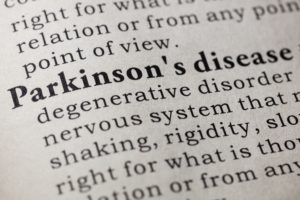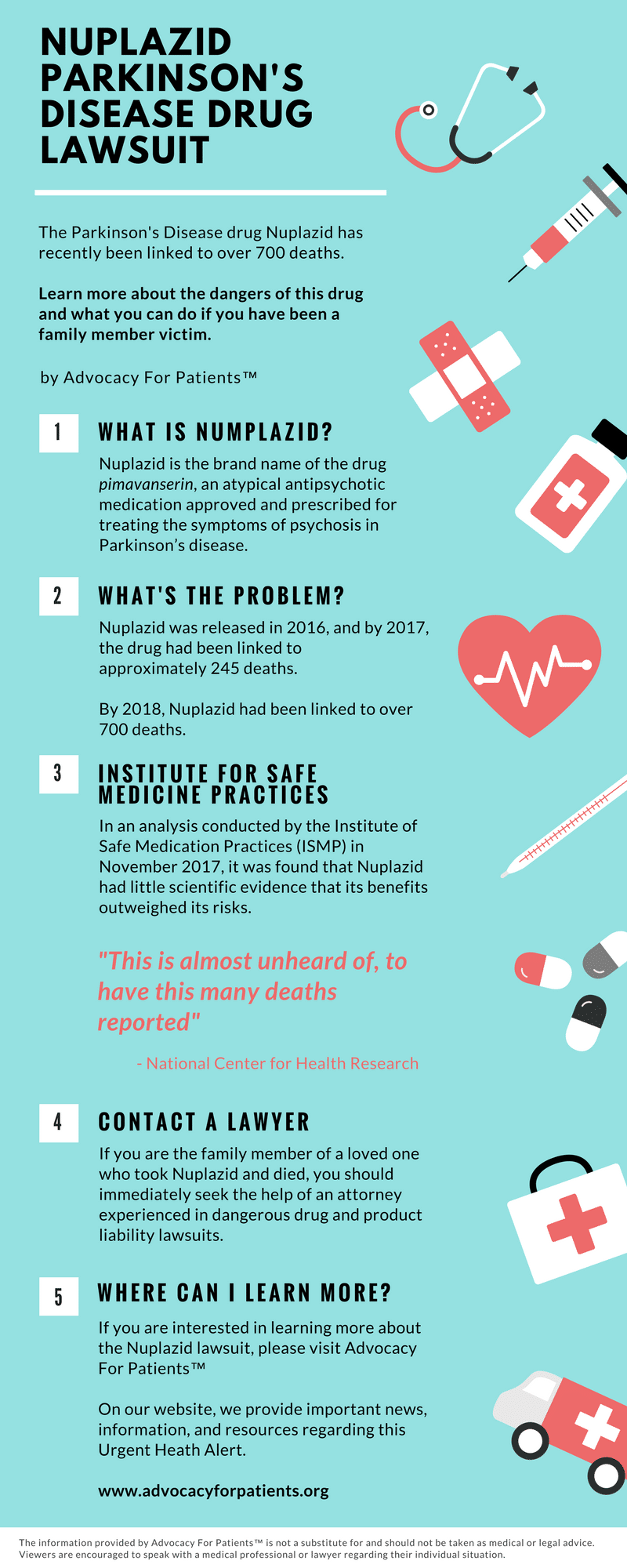Contents
- 1 What is Nuplazid?
- 2 Nuplazid uses and side effects
- 3 What is the controversy?
- 4 Confusing & Conflicting Research
- 5 What is Parkinson’s disease?
- 6 What causes Parkinson’s disease?
- 7 Who are more at risk?
- 8 History of Parkinson’s disease
- 9 Earliest treatments of Parkinson’s disease
- 10 Famous people with Parkinson’s disease
- 11 Parkinson’s disease and psychosis
- 12 What causes psychosis in Parkinson’s?
- 13 Other uses for Nuplazid
- 14 Conclusion
 Debilitating neurological diseases affect many people worldwide, and so many of them have no cure. One such life-limiting disease affecting nearly one million people in the US is Parkinson’s Disease.
Debilitating neurological diseases affect many people worldwide, and so many of them have no cure. One such life-limiting disease affecting nearly one million people in the US is Parkinson’s Disease.
Several studies have found that Parkinson’s Disease alone affects more people than other debilitating illnesses such as multiple sclerosis, muscular dystrophy, and Lou Gehrig’s disease combined. Every year, more than 60,000 people are affected by the disease. Parkinson’s disease has no cure, but there are medications used to control the symptoms. If you saw the great show The Good Wife – Louis Canning – had a disease along these lines.
Most medications used to control and manage the symptoms of Parkinson’s disease work slowly. In many cases, the severity of the illness can make the medications ineffective. In such cases, a “breakthrough therapy” is required.
One such drug that was approved by the FDA under the breakthrough therapy process is Nuplazid. The breakthrough therapy allows for faster approval of drugs because they are believed to be more effective than existing medications.
However, the antipsychotic drug has recently been the subject of several controversies, because it has allegedly caused as many as 700 deaths since it was released in June 2016.
What is Nuplazid?

Developed by Acadia Pharmaceuticals, the drug controls the symptoms of psychosis by changing the actions of chemicals in the brain. Although the drug has existed since 2014, it was only approved in 2016, after several families of Parkinson’s Disease patients requested the FDA to approve the drug, because they believed it was the only effective way to control psychosis.
Nuplazid is also used to treat hallucinations and delusions, hearing and seeing things and harboring false beliefs. These symptoms are also related to mood disorders and depression, and a type of Nuplazid is being developed to be effective for those conditions. Nuplazid is known as an atypical antipsychotic, because it doesn’t cause disabilities, unlike other drugs in this class.
Nuplazid uses and side effects

Rashes, itching, swelling of the face, tongue, or throat, and difficulty breathing may also occur in adverse conditions. Taking this drug along with other medications can also increase the risk of side effects.
As with every medication, there are side effects of Nuplazid as well. However, reports of death in as many as 700 patients since 2016 has sparked fresh concern regarding the safety of the drug.
Since Nuplazid was approved under the breakthrough therapy process, because several families of Parkinson’s disease patients believed it was the only treatment to deal with the psychosis, the FDA may have not studied all the risks and side effects carefully enough, as has been admitted by the FDA itself.
What is the controversy?

In 2012, Congress created the breakthrough therapy process in order to speed up the approval process. In this process, drugs that have been found to be more effective than those already on the market are approved sooner. Since 2012, nearly 200 drugs have been approved under this process.
In the case of Nuplazid, the review was expedited under this process. Several families pleaded with the FDA to approve the drug quickly because it would control the symptoms of psychosis in their loved ones. The FDA committee voted 12-2 on this matter, approved the drug for the treatment of psychosis in Parkinson’s disease based on the results of a six-week study involving 200 patients.
The drug was released in 2016, and by 2017, the sales climbed to $125 million. However, the FDA now thinks that the drug was risky after all.

The analysis also uncovered that the FDA’s medical reviewer had advised against approval but it was overruled. The reviewer had noted that although a lot of drugs are often approved based on limited medical and clinical evidence, in the case of Nuplazid, the risks are far greater than the benefits.
The analysis also found that the drug was making some cases of psychosis worse. At the time of the study, the reports of deaths were around 245. By the time the FDA took notice, the number had climbed to 700. When it was found that Nuplazid was possibly causing the deaths, families began investigating the filing of Nuplazid lawsuits against the manufacturer. Since 2016, there have been over 5,000 incidents involving problems with the drug. Falls, fatigue, and nausea were some of the problems, and death in the most severe cases.
Several patients and their families who once hoped that Nuplazid would help control the symptoms of psychosis in Parkinson’s disease have now raised safety concerns about the drug. A number of law firms are currently filing Nuplazid lawsuits on behalf of those who have lost their loved ones after using the drug.
Confusing & Conflicting Research
Medical researchers, who have been studying the drug and its effects, have said that they don’t yet know if Nuplazid is directly the cause of the death in Parkinson’s patients. Acadia Pharmaceutical also analyzed the reports by ISMP and concluded that the mortality rate was lower among those taking Nuplazid, as opposed to patients who were on other medications.
When researchers were contacted about the reports, they said that without additional studies, it was not possible to determine the risks of Nuplazid. Such routine scientific studies are done on drugs that get an expedited approval by the FDA.
At this point, both the FDA and Acadia are studying the effects of Nuplazid, while the Parkinson’s Foundation has asked patients to consult with their doctors in case they see any adverse reactions to the medication. Nuplazid is still available in the market, and several patients who haven’t experienced any adverse reaction to the drug continue to use it.
What is Parkinson’s disease?

The trembling may start in one limb but it gradually spreads across the body, making muscles weaker and stiffer, movements slower, and deteriorating balance and coordination. Other issues such as depression, cognitive disorders set in as the disease progresses.
The vast majority of people suffering from Parkinson’s disease usually got the disease above the age of 50, but young-onset of the disease isn’t uncommon. The disorder is slightly more common in men than in women. The worst part about the disease is that there’s no cure.
What causes Parkinson’s disease?

Since dopamine signals the appropriate parts of the brain when we want to move a part of our body, when the levels of the chemical start to drop the bodily movements are affected. When the dopamine level hits an all-time low, the person cannot control their movements well enough anymore. This is one of the biggest indicators of Parkinson’s disease.
It isn’t yet certain what causes the cells to die. Scientists assume that the reason could be a mix of genes, environment, and lifestyle that play a role.
Who are more at risk?
Scientists aren’t sure what causes the risk of the disease, but have reached some conclusions after years of research. Some of the factors that increase the risk factor are:
Age: People over 60 are more likely to get the disease.
Family history: If any parent or sibling has the disease, the risk is higher.
Occupation: Certain types of work have been linked to Parkinson’s, including farming or factory jobs, because they involve some chemicals that heighten the risk.
Race: White people are more likely to get it than others.
Serious head injury: If someone suffers from serious head injury at some point in life, they may be likely to develop Parkinson’s later.
Gender: Men are more at risk than women.
Where you live: Those who live in rural areas may be more likely to get the disease because of the chemicals used in farming.
History of Parkinson’s disease
Although Parkinson’s disease has been most popular in modern times, it has existed since time immemorial. The earliest references to the disease can be traced back to the 12th century BC, when an Egyptian papyrus mentioned a drooling king. The Bible also has a few mentions of tremors much like those who suffer from Parkinson’s disease.
Even earlier, in the 10th century BC, an Ayurvedic medical essay described a disease that caused tremors, stopped movement, and other symptoms associated with Parkinson’s disease. Greek physician Galen also described the disease as one that caused tremors, changes in posture, and paralysis.
In this century, there were no other references to the disease or its symptoms after the descriptions by Galen. The descriptions started again in the 17th century, with several authors writing about characteristics related to the disease.
Dutch physician and scientist Franciscus Sylvius, on similar lines as Galen, differentiated between tremors at rest and other tremors, while German physician and chemist Hieronymus David Gaubius described the signature gait in Parkinson’s disease by the term festination.
In the same century, Scottish surgeon and scientist John Hunter thoroughly described the disease. One of the final mentions in the 17th century was by French pathologist Auguste François Chomel, and it included several descriptions of the characteristics of the disease, such as abnormal movements and rigidity.
It wasn’t until the 19th century that the disease got a proper definition. The English scientist, geologist, and apothecary James Parkinson was the first person to write a detailed essay on the disease that later was named after him.
In 1817, Parkinson’s essay The Shaking Palsy, was the first ever such documentation to provide insight into the disease. What is remarkable is that the observations made by Parkinson back in the early 19th century still remain relevant today.
In the essay, Parkinson described the symptoms in six people, three of whom were his own patients. In the essay, the disease is referred to as asparalysis agitans, or shaking palsy. The main area of the essay was the differentiation between resting tremors and tremors with motion. Also mentioned were paralysis, gait, muscle weakness, and the gradual progression of the disease.
Although his essay is now regarded as the first such piece on the disease, it received little acknowledgement back then. The term Parkinson’s disease was coined by French neurologist and professor Jean-Martin Charcot sixty years later.
Other notable people who contributed to the study of the disease include French internist Armand Trousseau, British neurologist William Gowers, British American neurologist Samuel Kinnier Wilson, German neurologist Wilhelm Heinrich Erb, and Charcot. There were several studies by Charcot between 1868 and 1881 that proved to be a milestone in understanding the disease. It was Charcot who made the distinction between weakness, rigidity, and bradykinesia.
It wasn’t until the 20th century that more in depth studies were conducted on the disease. James Parkinson had erroneously thought that the disease started in the medulla region, but later in the 20th century it was discovered that the disease was a result of the dopamine levels in the brain.
It was during the 20th century that Frederic Lewy identified the disease later known as Lewy Bodies. Russian neuropathologist Konstantin Tretiakoff was the one to first report that the substantia nigra was the affected part of the brain leading to Parkinson’s disease, but this wasn’t accepted until German pathologist Rolf Hassler confirmed it through various studies in 1938.
The effects of the changes in the dopamine levels were identified in the 1950s, by Swedish neuropharmacologist Arvid Carlsson while and Austrian biochemist Oleh Hornykiewicz identified the chemicals that pertain to Parkinson’s disease. Carlsson also received the Nobel Prize for this work.
Earliest treatments of Parkinson’s disease

In the mid-20th century, neurosurgeons started performing surgery on the basal ganglia of the brain, and it also helped improve some symptoms of the disease. However, the surgery also had its own risks, and out of those who were operated on, about 10 percent of them died.
It was in the 1960s that a breakthrough came about in Parkinson’s treatment. This was when it was identified by researchers that it is the dopamine level that causes poor posture and movement and motor activities in people with Parkinson’s disease.
This research led to the first proper treatment for the disease, resulting in some of the first drugs meant to control the symptoms. Levodopa was one of the first medicines to be invented, which increased levels of dopamine in the brain. Levodopa is still considered the first proper medication that was ever available for treating Parkinson’s disease.
Alternative treatments have also been used in early days, most noted being traditional Indian Ayurveda. Herbs such as cowitch and velvet beans were used in the olden days to treat the disease, because they naturally contain levodopa.
Today, the most common medications used to treat Parkinson’s disease include a combination of levodopa and carbidopa, because the latter counters some of the side effects of levodopa. Although these medications are effective in the first five or ten years, they gradually stop working and can also lead to adverse reactions such as tics and involuntary movements.
There are other Parkinson’s medications that mimic the effect of dopamine. Known as dopamine agonists, some of these drugs are pramipexole, cycloset bromocriptine, and ropinirole. They are usually used together with levodopa.
Before these medications were invented, it was common to perform brain surgery to treat symptoms of Parkinson’s. Today, however, surgery is used again in some cases, to destroy selective areas of the brain, in order to control some symptoms of the disease. The method used today is called deep brain stimulation, where an electrode is planted into the brain to control the symptoms of Parkinson’s disease. This is known to be a safe process.
Some home remedies are used to relieve Parkinson’s symptoms. These include exercise, physical therapy, occupational therapy, speech therapy, and counseling.
Famous people with Parkinson’s disease

Some of the most famous people, dead or living, who suffered from the disease are as follows.
Adolf Hitler: One of the most famous people in history to have suffered from the disease is the propagator of Nazism, Adolf Hitler. It is speculated Hitler had Parkinson’s disease, because by the end of his life, his hands trembled at rest, and because of his cognitive disorder he was unable to make decisions based on the reality of the situation at hand. It is also said that it was Parkinson’s related cognitive disorder that made him so obsessive.
Salvador Dali: The Spanish artist was one of the several painters who have been said to have Parkinson’s disease. Although it was never confirmed, scientists have found that the later paintings by the artist reveal a change in strokes than the ones in his early paintings. The painter also suffered from heart disease, but died in a fire at home in 1989.
Muhammad Ali: Boxing legend Muhammad Ali was diagnosed with the disease in 1984 because of severe head injuries suffered during his career. Along with the philanthropist Jimmy Walker, Ali formed the Muhammad Ali Parkinson Center, to raise awareness about the disease. Besides Parkinson’s, Ali was also associated with other movement disorders, such as Huntington’s disease.
Pope John Paul II: The pontiff (the leader of the Catholic Church which recognized Jesus as the son of God all the way back to the disciples of Jesus himself) was diagnosed with the disease back in 1991, but it was hidden from public until 2003. Since 1996, observers had begun to question the constant trembling of the Pope’s hands, but there was never any official declaration from the Vatican because they feared damaging his reputation. The pontiff’s physician of 25 years later made it public that the Pope had been suffering from the disease long before 2003.
Johnny Cash: Legendary country singer Johnny Cash was diagnosed with Parkinson’s in 1997. When Cash’s spokeswoman made a public announcement about the singer’s condition, every major music platform, from Rolling Stone magazine to MTV, was agog with the news. Fans found it hard to believe that the man in black would no longer be able to tour. Cash also suffered from a number of other ailments, including heart disease and knee problems. His health concerns were attributed to the years of drug abuse.
Frank Kelly: Irish acting legend Frank Kelly, famous for his role as Father Jack in Father Ted, announced in 2015 that he had been suffering from the disease for a while. Despite the diagnosis, the actor has been determined to keep acting.
Michael J Fox: Actor Michael Fox is one of the most famous people with the disease, and has been the face of Parkinson’s awareness ever since his diagnosis in 1991 (his character in the amazing show The Good Wife incorporated this disease). Although Parkinson’s affects people over the age of 50 or 60, Fox was diagnosed at 30. He revealed his diagnosis 1998, and founded the Michael J. Fox Foundation for Parkinson’s Research in 2000.
Most remember Fox as the young actor in the 1980s comedy show Family Ties and the Back to the Future movie series. He still continues to act, playing characters with Parkinson’s in shows such as The Good Wife (as just mentioned) and Curb Your Enthusiasm. The actor is committed to building awareness and researching about the disease.
Robin Williams: After the actor’s death in 2014, his widow revealed that the actor had been suffering from Parkinson’s disease, and had no more than three years to live. Later, however, it was revealed that the actor was suffering from Lewy bodies dementia, a disease that mimics Alzheimer’s and Parkinson’s. The common symptoms often lead the disease to be misdiagnosed. It is rumored that the cognitive disorders drove the actor to suicide.
Brian Grant: The NBA professional was a top player for 12 seasons, known for his positive attitude, commitment to the game, and his work with underprivileged children. Grant was diagnosed with young-onset Parkinson’s disease in 2008, at only 36 years, shortly after retirement. He founded the Brian Grant Foundation, which works to raise awareness about the disease.
Maurice White: As one of the founders of the band Earth, Wind, & Fire, Maurice White observed the earliest signs of the disease back in the 80s, but did not do anything about it then because the band was at its peak. Even after he was diagnosed in 1992, he kept it hidden for eight years. Later, he revealed that he had traveled with the band after his diagnosis for five years, but the disease was not able to affect him much because it was controlled with medications. One of the most famous musicians with Parkinson’s, White died at age 74 in 2016.
Neil Diamond: The man behind hits like “Girl, You’ll Be a Woman Soon,” “Cracklin’ Rosie,” and “Red, Red Wine” had to give up touring after being diagnosed with Parkinson’s in January 2018. On his 50th anniversary tour at the time, Diamond had to cancel upcoming concert dates in Australia and New Zealand.
He also said that he would continue to write and record music, but would no longer perform live. The singer with the rich bass baritone was inducted into the Rock n Roll Hall of Fame at this year’s Grammy Awards.
Bob Hoskins: The British actor best known for his award-winning performance in The Long Good Friday was forced to retire after being diagnosed with the disease in 2012. Although private about the details of the disease, he did admit that it was because of the diagnosis that he was forced to retire, choosing to focus on his health. He died of pneumonia in 2014, aged 71.
Parkinson’s disease and psychosis

Psychosis can be classified into two categories: hallucinations and delusions.
Hallucinations are primarily visual in nature, although a small percentage of patients may also experience auditory hallucinations, such as hearing things.
Delusions are also common among Parkinson’s patients. These fixed false beliefs usually follow a pattern. For instance, several Parkinson’s patients with psychosis may believe that their spouse in cheating on them. They may believe that people are trying to steal their belongings, kill them, harm them, poison their food, or replace their medications with something else.
This kind of paranoia often leads them to take immediate action; it isn’t at all uncommon for such patients to call police to report that people are trying to hurt them or rob them.
In the early stages of the conditions, patients are able to distinguish their hallucinations and delusions from reality. They realize that what they are seeing or hearing isn’t actually there.
But this may worsen as the disease progresses. As time goes by, patients are unable to distinguish between the reality and what they are experiencing. They start believing their hallucinations are real. Symptoms of psychosis in Parkinson’s disease patients occur during the evening in the initial stages, but later can occur at any time.
It must be noted that psychosis doesn’t develop until several years after the diagnosis. If psychosis symptoms are present from the beginning, it is usually a different disease.
The psychosis symptoms make treatment and caregiving difficult. It has been found that psychosis was the primary reasons why some Parkinson’s patients require institutionalization.
What causes psychosis in Parkinson’s?
There can be several causes behind hallucinations and other psychosis symptoms in Parkinson’s patients. Medications, lack of sleep, infection, and dehydration are some of the biggest reasons. In elderly patients, dehydration stress, and urinary tract infections can be the cause of hallucinations and psychosis.
Medications used to treat Parkinson’s disease often have a hand in producing psychosis symptoms. Parkinson’s disease medications usually work by increasing the levels of dopamine in the brain.
It is important to do this, because when the dopamine levels are balanced, proper bodily movements and coordination can be restored. However, in doing so, psychosis symptoms can be produced. Several studies have found that dopamine plays a big role in causing hallucinations. When dopamine levels get a boost, the improved motor symptoms can produce psychosis.
Another reason behind the psychosis is the disease itself. As Parkinson’s disease progresses, it impairs cognitive and visual processes, leading to psychosis.
If the psychosis is not severe enough to bother the patient, then treatment isn’t required. Before prescribing treatment, doctors usually find out the cause of the psychosis. For instance, if it’s lack of sleep, then sleep medications are prescribed. If it’s because of an infection, then medications are given to treat it.
If the psychosis is as a result of the disease itself or because of the medications, then antipsychotic drugs may be prescribed. However drugs prescribed to treat the hallucinations are typical antipsychotic medicines, which work by blocking the dopamine receptors.
Although it manages to control the symptoms of psychosis, it leads to the worsening of Parkinson’s disease. Treating psychosis in Parkinson’s patients was a challenge until 2016, when FDA approved the drug Nuplazid, sold under the brand name Nuplazid.
When Nuplazid was first released, it was like a ray of hope for those suffering from Parkinson’s related psychosis. In fact, before the approval of Nuplazid, there was no medication to specifically treat psychosis in Parkinson’s disease. Drugs used for treating other psychiatric conditions, such as quetiapine or clozapine off-label, were prescribed in small doses.
These drugs control psychosis symptoms to some extent, but also cause severe side effects such as worsening of motor symptoms, drowsiness, constipation, and lack of balance.
Moreover, since families usually don’t report psychosis symptoms to the doctor treating the patient because they are not sure if the psychosis is part of the illness. They usually think the psychosis is a result of something else. This is why it is important for the doctor to ask the family about any symptom of psychosis in the patient.
Despite its side effects, Nuplazid has been recognized as the only drug effective in treating psychosis in Parkinson’s disease. Nuplazid has been specifically designed to treat psychosis without making the motor symptoms of Parkinson’s worse. Unlike other psychiatric drugs that work by targeting the dopamine receptors, Nuplazid works by targeting the serotonin receptors in the brain.
Several foundations for Parkinson’s disease have advocated the use of Nuplazid for treating psychosis in Parkinson’s disease. In fact, the drug has been seen to be more effective for people with Parkinson’s psychosis, than for people without psychosis. Since the options for treating dementia in Parkinson’s patients are limited, the drug is extremely promising.
After being approved by the FDA, thousands of people rushed to get their loved ones on the drug. Some that have used the drug have shown significant improvement in their psychosis symptoms.
Other uses for Nuplazid
Besides Parkinson’s disease, Nuplazid is also used for treating psychosis resulting from other conditions, including schizophrenia, dementia, and Alzheimer’s disease.
Nearly eight million live with dementia, of which nearly 30 percent have psychosis symptoms such as hallucinations and delusions. Although a severe condition, dementia-related psychosis had no other FDA-approved medication before Nuplazid.
Symptoms of dementia-related psychosis can also be found in Alzheimer’s disease, Lewy bodies disease, Parkinson’s disease, and vascular dementia. Psychosis can have serious consequences and require hospital admissions in many cases. It also enhances the risk of mortality.
Alzheimer’s is another disease where psychosis and aggression is often reported. In large scale clinical trials, it was found that the frail, vulnerable elderly patients suffering from terrifying symptoms benefited the most from Nuplazid. In most cases, such patients were prescribed sedatives along with typical antipsychotic drugs, even though they caused health issues and even death.
Researchers and scientists expressed hope at the encouraging results given by Nuplazid. The initial trials led to a larger phase 3 clinical trial that also proved the benefits of Nuplazid in psychosis patients. The trial involved studying the safety and efficiency of Nuplazid in 200 patients with Alzheimer’s disease and Parkinson’s psychosis, with 100 of them given Nuplazid and the other half given a placebo.
Acadia is also studying the benefits of Nuplazid in schizophrenia patients. All typical antipsychotic medications prescribed to treat psychiatric disorders target the dopamine receptors, leading to lower dopamine levels in the brain. However, dopamine being essential for balance and coordination and motor activities, its low level lead to lack of coordination, muscle weakness, and trembling.
In many cases, even schizophrenia patients start suffering from muscle weakness and lack of balance, coordination, and cognitive disorders after being put on antipsychotic drugs.
With the release of Nuplazid, researchers have found hope in treating psychosis symptoms of schizophrenia and other psychiatric conditions. Although Nuplazid is currently only prescribed for Parkinson’s disease, Acadia is trying to make it effective for other psychiatric disorders as well.
Despite the reports that Nuplazid has been the cause of death in over 700 patients, it has not yet been proved that it was the drug that was responsible for the deaths. Therefore, the FDA and federal regulators don’t have a reason yet to ban the medication. Instead, additional warnings are being issued for those taking the drug, and have been asked to consult doctors if they see any adverse reactions to the drug.
Acadia Pharmaceuticals and the FDA continue to stress that the drug’s potential benefits are still far greater than the risks, and that Nuplazid is the only treatment right now for people who suffer from Parkinson’s related psychosis. Acadia has stated that the mortality rate was high because Nuplazid is given to patients in the most advanced stages of the stages, when death is most likely.
The company also asserted that it distributes the drug through a network of specialty pharmacies, and if there were reports of deaths in patients, Acadia would the first to know about it, before informing the FDA. It also said that the increased hallucinations could be because of the effects of the drugs being taken before starting to take Nuplazid.
Conclusion
Despite the wide spread of the disease, Parkinson’s is yet to have a cure. From paralysis to psychosis, the debilitating symptoms of the disease are hard to cope with. However, researchers have made a lot of progress in the last few years, and are now hopeful that the development of Parkinson’s can be stopped.

